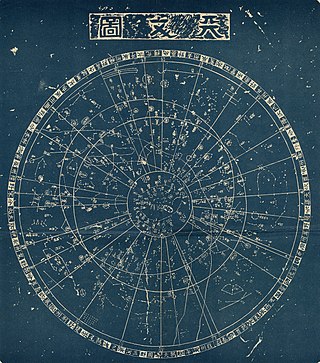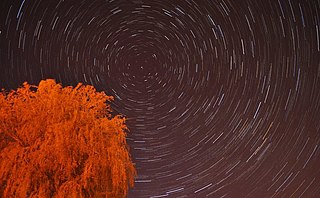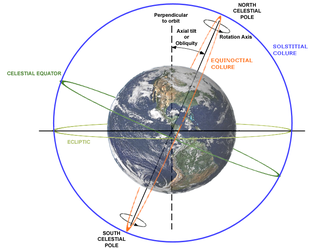
A constellation is an area on the celestial sphere in which a group of visible stars forms a perceived pattern or outline, typically representing an animal, mythological subject, or inanimate object.

A Flamsteed designation is a combination of a number and constellation name that uniquely identifies most naked eye stars in the modern constellations visible from southern England. They are named for John Flamsteed who first used them while compiling his Historia Coelestis Britannica.

Taurus is one of the constellations of the zodiac and is located in the northern celestial hemisphere. Taurus is a large and prominent constellation in the Northern Hemisphere's winter sky. It is one of the oldest constellations, dating back to the Early Bronze Age at least, when it marked the location of the Sun during the spring equinox. Its importance to the agricultural calendar influenced various bull figures in the mythologies of Ancient Sumer, Akkad, Assyria, Babylon, Egypt, Greece, and Rome. Its old astronomical symbol is (♉︎), which resembles a bull's head.

The galactic coordinate system is a celestial coordinate system in spherical coordinates, with the Sun as its center, the primary direction aligned with the approximate center of the Milky Way Galaxy, and the fundamental plane parallel to an approximation of the galactic plane but offset to its north. It uses the right-handed convention, meaning that coordinates are positive toward the north and toward the east in the fundamental plane.

Traditional Chinese astronomy has a system of dividing the celestial sphere into asterisms or constellations, known as "officials".

A circumpolar star is a star that, as viewed from a given latitude on Earth, never sets below the horizon due to its apparent proximity to one of the celestial poles. Circumpolar stars are therefore visible from said location toward the nearest pole for the entire night on every night of the year. Others are called seasonal stars.

The Winter Triangle is an astronomical asterism formed from three of the brightest stars in the winter sky. It is an imaginary equilateral triangle drawn on the celestial sphere, with its defining vertices at Sirius, Betelgeuse, and Procyon, the primary stars in the three constellations of Canis Major, Orion, and Canis Minor, respectively.

In contemporary astronomy, 88 constellations are recognized by the International Astronomical Union (IAU). Each constellation is a region of the sky bordered by arcs of right ascension and declination, together covering the entire celestial sphere. Their boundaries were officially adopted by the International Astronomical Union in 1928 and published in 1930.

A pole star is a visible star that is approximately aligned with the axis of rotation of an astronomical body; that is, a star whose apparent position is close to one of the celestial poles. On Earth, a pole star would lie directly overhead when viewed from the North or the South Pole.

An asterism is an observed pattern or group of stars in the sky. Asterisms can be any identified pattern or group of stars, and therefore are a more general concept than the 88 formally defined constellations. Constellations are based on asterisms, but unlike asterisms, constellations outline and today completely divide the sky and all its celestial objects into regions around their central asterisms. For example, the asterism known as the Big Dipper comprises the seven brightest stars in the constellation Ursa Major. Another is the asterism of the Southern Cross, within the constellation of Crux.

The Winter Hexagon or Winter Circle/Oval is an asterism appearing to be in the form of a hexagon with vertices at Rigel, Aldebaran, Capella, Pollux, Procyon, and Sirius. It is mostly upon the Northern Hemisphere's celestial sphere. On most locations on Earth, this asterism is visible in the evening sky at the equator from approximately December to June, and in the morning sky from July to the end of November, while in the evenings on the northern hemisphere it is less months visible between December and June, and on the southern hemisphere less months between July and November. In the tropics and southern hemisphere, this can be extended with the bright star Canopus in the south.

Colure, in astronomy, is either of the two principal meridians of the celestial sphere.

The following outline is provided as an overview of and topical guide to astronomy:

Constellation families are collections of constellations sharing some defining characteristic, such as proximity on the celestial sphere, common historical origin, or common mythological theme. In the Western tradition, most of the northern constellations stem from Ptolemy's list in the Almagest, and most of the far southern constellations were introduced by sailors and astronomers who traveled to the south in the 16th to 18th centuries. Separate traditions arose in India and China.
Gould designations for stars are similar to Flamsteed designations in the way that they number stars within a constellation in increasing order of right ascension. Each star is assigned an integer, followed by " G. ", and then the Latin genitive of the constellation it lies in. See 88 modern constellations for a list of constellations and the genitive forms of their names.
This table lists those stars/objects which have Flamsteed designations by the constellation in which those stars/objects lie. The name given is that of the article if it does not reflect the Flamsteed designation. Some articles are linked twice, in cases where the star has been assigned two different Flamsteed designations, usually as noted in different constellations.

Urania's Mirror; or, a view of the Heavens is a set of 32 astronomical star chart cards, first published in November 1824. They are illustrations based on Alexander Jamieson's A Celestial Atlas, but the addition of holes punched in them allow them to be held up to a light to see a depiction of the constellation's stars. They were engraved by Sidney Hall, and were said to be designed by "a lady", but have since been identified as the work of the Reverend Richard Rouse Bloxam, an assistant master at Rugby School.

The southern celestial hemisphere, also called the Southern Sky, is the southern half of the celestial sphere; that is, it lies south of the celestial equator. This arbitrary sphere, on which seemingly fixed stars form constellations, appears to rotate westward around a polar axis as the Earth rotates.
















